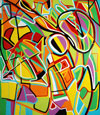Robin Sperling Sulfurpuszta Here simplicity shouldn't be confused with minimalism. Minimalism refers to the style of artists whose main gripe with the art of painting was it's two-dimensional nature. They created art works that might be dubbed installations today, but with an emphasis on light, purity and the utopian aesthetics of the 1960s. The minimalists created art works that, in this author's opinion, were attractive design objects, but in painting, minimalism has never developed into a recognizable artistic language. The success of abstract art is illustrated by our ability to discern abstract artists whose style can be recognized as simultaneously universal and personal. In spite of it's simplicity, Sulfurpuszta is a captivating and complete painting. It's roots might lie in the post-painterly abstraction of the 1960s, in the way the greater part of the painting consists of a single color that creates a light-effect that dominates the painting. The grid looks like it was scratched into a metal surface before the paint was applied. |

The brown in the painting on the left looks like an orange-red, polluted with black or the complementary color, as all browns are either yellow (as in yellow ocre), orange (the pigments sienna and umber, originally derived from the soil of the Italian towns that bear those names) or red (iron oxide, the color of clay tennis courts). I assume that the dark parts of the painting result from mixing the blue with the brown, which suggests in fact that the brown is orange, because only blue's complementary color will produce a color nearing black, if mixed with blue. Note how loosely this art work was painted, a sign of Robin Sperling's excellent abstract technique. As with Sulfurpuszta the painting above is simple in geometry and consists of only two pure colors, yet the painting is varied and dynamic, subtle in color and light and very well balanced. |





